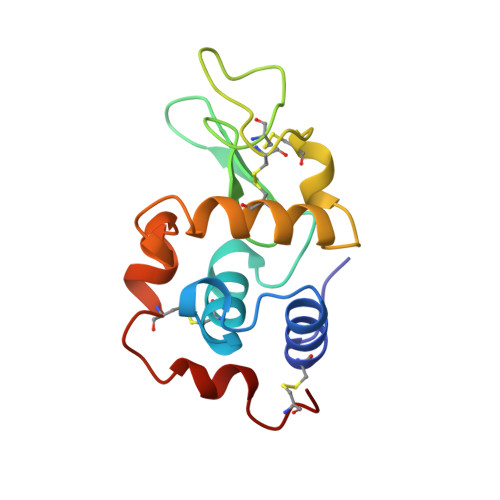Elucidation of Metal-Ion Accumulation Induced by Hydrogen Bonds on Protein Surfaces by Using Porous Lysozyme Crystals Containing Rh(III) Ions as the Model Surfaces
Ueno, T., Abe, S., Koshiyama, T., Ohki, T., Hikage, T., Watanabe, Y.(2010) Chemistry 16: 2730-2740
- PubMed: 20146274
- DOI: https://doi.org/10.1002/chem.200903269
- Primary Citation of Related Structures:
3A8Z, 3A90, 3A91, 3A92, 3A93, 3A94, 3A95, 3A96 - PubMed Abstract:
Metal-ion accumulation on protein surfaces is a crucial step in the initiation of small-metal clusters and the formation of inorganic materials in nature. This event is expected to control the nucleation, growth, and position of the materials. There remain many unknowns, as to how proteins affect the initial process at the atomic level, although multistep assembly processes of the materials formation by both native and model systems have been clarified at the macroscopic level. Herein the cooperative effects of amino acids and hydrogen bonds promoting metal accumulation reactions are clarified by using porous hen egg white lysozyme (HEWL) crystals containing Rh(III) ions, as model protein surfaces for the reactions. The experimental results reveal noteworthy implications for initiation of metal accumulation, which involve highly cooperative dynamics of amino acids and hydrogen bonds: i) Disruption of hydrogen bonds can induce conformational changes of amino-acid residues to capture Rh(III) ions. ii) Water molecules pre-organized by hydrogen bonds can stabilize Rh(III) coordination as aqua ligands. iii) Water molecules participating in hydrogen bonds with amino-acid residues can be replaced by Rh(III) ions to form polynuclear structures with the residues. iv) Rh(III) aqua complexes are retained on amino-acid residues through stabilizing hydrogen bonds even at low pH (approximately 2). These metal-protein interactions including hydrogen bonds may promote native metal accumulation reactions and also may be useful in the preparation of new inorganic materials that incorporate proteins.
Organizational Affiliation:
Institute for Integrated Cell-Material Sciences (iCeMS), Kyoto University, Katsura, Nishikyo-ku, Kyoto 615-8510, Japan. taka@sbchem.kyoto-u.ac.jp

















